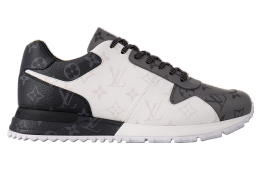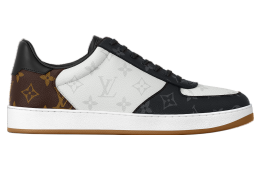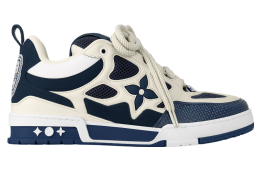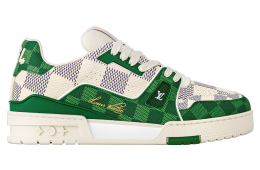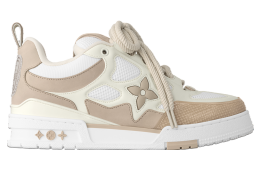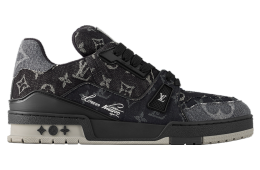Louis Vuitton
Louis Vuitton, the French luxury fashion house known for its iconic monogram and sophisticated apparel, has made significant strides in the sneaker market. Their sneakers, which seamlessly blend high fashion with streetwear aesthetics, are instantly recognizable. They are crafted with exceptional materials such as fine leathers, suedes, and high-tech fabrics, ensuring both durability and a premium feel. The brand's meticulous attention to detail is evident in every aspect of the sneaker design, including intricate stitching, metal accents, and embossed logos. As a result, Louis Vuitton sneakers have become a symbol of status and style, appealing to both fashion enthusiasts and sneaker collectors alike.
In recent years, under the creative direction of designers like Virgil Abloh, Louis Vuitton has pushed the boundaries of their sneaker offerings, incorporating bold and unexpected elements that reflect contemporary street culture. The collection includes a wide range of styles, from the chunky, retro-inspired Archlight sneakers to the minimalist, sleek silhouettes of the LV Trainer. Each release is anticipated with great excitement, often accompanied by limited edition runs and collaborations with artists and other brands. This innovative approach not only keeps the sneaker line fresh and relevant but also strengthens Louis Vuitton's position in the competitive world of luxury footwear.
read moreHistory of Louis Vuitton
The History of Louis Vuitton
Early Beginnings and Foundation:
Louis Vuitton, a name synonymous with luxury and elegance, has a rich history that dates back to the mid-19th century. The journey began in 1821 when Louis Vuitton was born in Anchay, a small town in eastern France. At the age of 16, Vuitton set out for Paris, traveling by foot over the course of two years. Once in Paris, he began an apprenticeship with Romain Maréchal, a successful box-maker and packer. This experience laid the foundation for Vuitton's craftsmanship and understanding of high-quality materials.In 1854, Louis Vuitton opened his first store in Paris at 4, Rue Neuve-des-Capucines. He established his brand with the idea of creating reliable, durable, and aesthetically pleasing luggage. One of his earliest innovations was the creation of flat-topped trunks. Prior to this, most travel trunks had rounded tops to allow water runoff, but they were inefficient for stacking. Vuitton's trunks, made from waterproof canvas, were not only stackable but also lightweight, revolutionizing travel logistics.
Innovation and Expansion:
The success of Vuitton’s flat-topped trunk led to an increase in demand. In response, he expanded his workshop in 1858 and continued to innovate. He introduced the gray Trianon canvas, a material that was lightweight, durable, and waterproof. His commitment to quality craftsmanship and innovative design quickly earned him a prestigious clientele, including Empress Eugénie de Montijo, wife of Napoleon III.Vuitton’s company experienced impressive growth, and in 1871, he moved his workshop to the larger premises of Asnières-sur-Seine, a suburb in Paris. This site would become the center of Louis Vuitton's craftsmanship and remains operational today. In addition to trunks, the company began producing a variety of luggage pieces, each meticulously designed to meet the needs of travelers.
The Iconic Monogram and Further Growth:
After Louis Vuitton’s death in 1892, his son Georges Vuitton took over the business. Georges was equally innovative and determined to continue his father’s legacy. In 1896, to honor his father and also to differentiate the brand from other imitators, Georges created the iconic LV monogram canvas. This print, featuring the interlocking LV initials and floral motifs, became a symbol of luxury and exclusivity.Under Georges' leadership, the brand diversified its product range and expanded internationally. By the early 20th century, Louis Vuitton had stores in major cities worldwide, including New York, London, and Buenos Aires. In 1914, the Louis Vuitton Building opened on the Champs-Elysées in Paris, becoming the largest travel-goods store in the world at the time.
Innovations and Patents:
The early 20th century saw continued innovations. In the 1920s, Louis Vuitton introduced the Steamer Bag, designed to be a smaller piece of luggage that could fit inside larger trunks. This led to the creation of more travel-friendly bags, including suitcases and handbags. The Keepall bag, introduced in 1930, became an instant success and remains one of the brand’s most popular items today.Throughout the 1930s, the company maintained a steady focus on innovation, quality, and exclusivity. The introduction of lighter materials and more versatile designs made Louis Vuitton products increasingly desirable. The Alma handbag, originally designed for Coco Chanel, became another emblematic piece in the brand’s collection.
Post-War Expansion and the LVMH Group:
The post-World War II era marked a new chapter for Louis Vuitton. Ibiza bags, adorned with the exclusive Damier pattern introduced initially in 1888, became popular, and in 1959, a new form of coated canvas allowed for more varied production. This period also saw the introduction of iconic products like the Noé bag, originally designed to carry champagne bottles, and the Speedy bag, which has become a timeless wardrobe staple.In 1987, Louis Vuitton underwent a significant transformation by merging with Moët et Chandon and Hennessy, leading to the creation of LVMH (Louis Vuitton Moët Hennessy), the world's largest luxury goods conglomerate. This merger propelled the brand into a new stratosphere of luxury goods, increasing its global presence and expanding its product lines.
Modernization and Continued Success:
The 1990s and 2000s saw Louis Vuitton embracing modernization while honoring its legacy. Under the guidance of creative directors like Marc Jacobs, the brand introduced ready-to-wear lines, footwear, and accessories, cementing its status as a fashion powerhouse. Jacobs also initiated collaborations with prominent artists such as Stephen Sprouse, who designed the graffiti collection, and Takashi Murakami, known for the Multicolore Monogram.In addition to fashion, Louis Vuitton ventured into other domains, including timepieces and jewelry. The Tambour watch collection, launched in 2002, showcased the brand’s dedication to craftsmanship and elegance. Louis Vuitton jewelry, featuring intricate designs and high-quality materials, quickly gained a reputation for sophistication and luxury.
Louis Vuitton in the 21st Century:
Entering the 21st century, Louis Vuitton continued its legacy of innovation and expansion. The brand embraced digital technology, launching e-commerce platforms and engaging in online marketing to reach a broader audience. Collaborations with contemporary artists and designers, such as Jeff Koons and Virgil Abloh, brought fresh perspectives and maintained the brand’s relevance in a fast-changing fashion landscape.In 2013, Nicolas Ghesquière assumed the role of artistic director for Louis Vuitton’s women’s collections, succeeding Marc Jacobs. Ghesquière’s vision combined the brand’s heritage with innovative, futuristic elements, leading to critically acclaimed collections. The men's division also saw a significant appointment in 2018 with Virgil Abloh, whose streetwear-infused aesthetics attracted a new generation of Louis Vuitton enthusiasts.
Under Ghesquière and Abloh, Louis Vuitton’s collections have continued to diversify and push boundaries. The brand has also made significant strides in sustainability, recognizing the importance of ethical practices in the luxury industry. Initiatives such as the Ecodesign Lab and commitments to reducing environmental impact reflect Louis Vuitton’s dedication to a more sustainable future.
Cultural Impact and Philanthropy:
Beyond its product offerings, Louis Vuitton holds a significant cultural impact. The brand’s exhibitions and museums, including the Fondation Louis Vuitton in Paris, showcase contemporary and historical works, blending art and fashion. The foundation, designed by architect Frank Gehry, is a testament to the brand’s commitment to creativity and cultural enrichment.Louis Vuitton’s influence extends to philanthropy as well. The brand engages in various charitable initiatives, supporting causes like education, disaster relief, and environmental conservation. Through partnerships and collaborations, Louis Vuitton strives to make a positive impact on global communities.
Reflection and Legacy:
Louis Vuitton’s story is a testament to the power of innovation, craftsmanship, and visionary leadership. From its humble beginnings with a young trunk-maker to becoming a global symbol of luxury, the brand has consistently set benchmarks in the fashion and luxury goods industry. The LV monogram, innovative designs, and dedication to quality have made Louis Vuitton an enduring icon.The success of Louis Vuitton is not merely rooted in its products but also in its ability to adapt and evolve. The brand’s seamless blend of tradition and innovation, along with its commitment to culture, sustainability, and philanthropy, ensures its continued relevance in an ever-changing world.
As Louis Vuitton looks to the future, it remains grounded in the values established by its founder over a century ago. Each creation, whether a classic trunk or a modern handbag, tells a story of excellence, capturing the essence of exploration, elegance, and the pursuit of the extraordinary.
Louis Vuitton’s legacy is not just about creating products but about inspiring dreams, pushing boundaries, and leaving an indelible mark on the world of fashion and beyond. The journey of Louis Vuitton is far from over, and its future promises new innovations, continued cultural impact, and unwavering dedication to the art of luxury.
